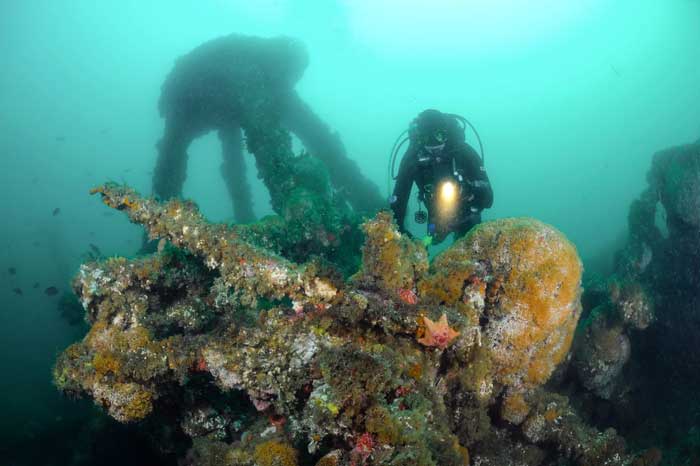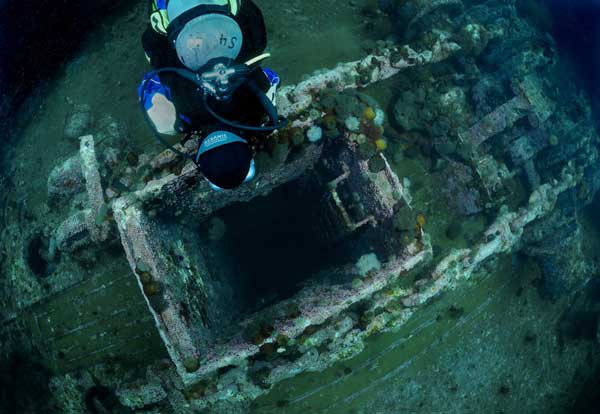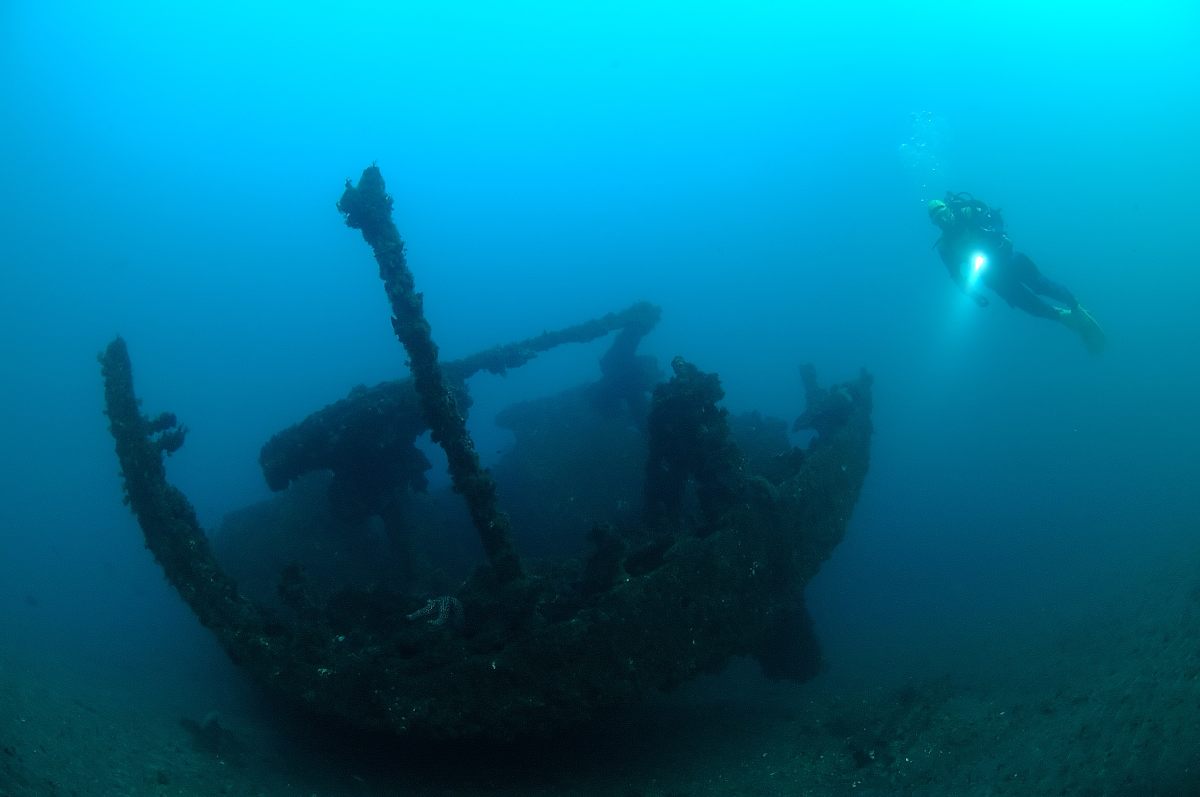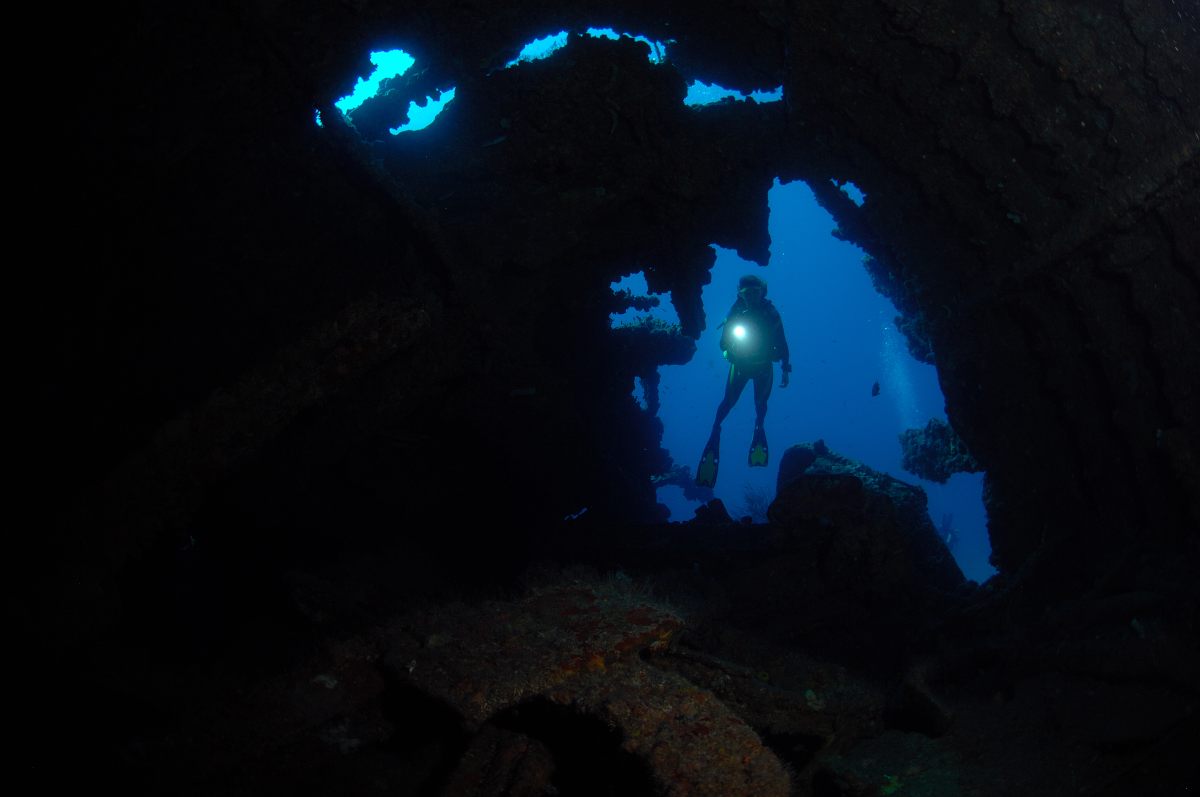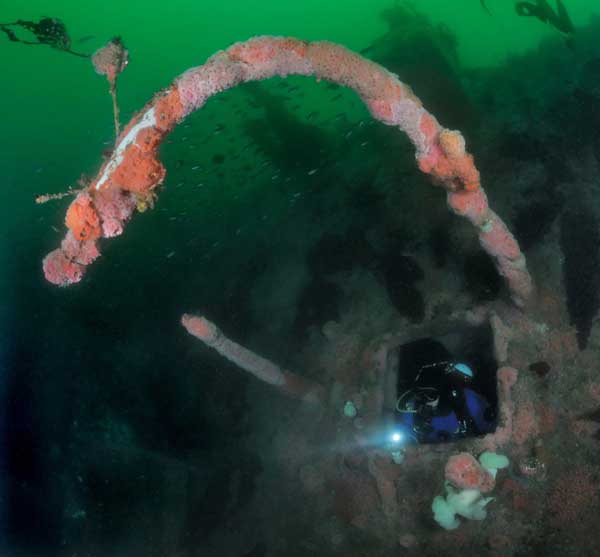Seeing a sunken hulk materialize out of the gloom is a thrill I never tire of. It doesn’t matter if it’s a ship, plane, or automobile, the siren song to come and explore is loud and clear. Beyond the booty one typically fantasizes about (gold, silver, and jewels) there is another kind of treasure associated with almost all wreckage under the sea – not to mention the usual bountiful marine life – and that is the mystery and history contained within its skeleton. We as divers get a chance to travel through time and touch a by gone era. Even artificial reefs, purposely sunk, often have a colorful past with which we can connect. It is this very allure however that can make visiting these undersea resting places a potentially hazardous affair. Whether it’s a submerged Chevy in a Kansas quarry or a WWII battleship in Bikini Atoll, they all share some of the same risks. People who wouldn’t dare swim into a hole in the ground or reef will eagerly place hundreds of tons of steel above them during a dive. Anytime you put a ceiling over your head be it steel, rock, or decompression you’ve gone from an open water dive to a technical overhead penetration pursuit.
The very nature of wreckage almost guarantees there will be entanglement hazards, sharp edges, confined spaces and, one of the most over looked problems until too late – disorientation. Popping your head into a hatch for a quick look around is a far different action then fining down corridors, turning corners, and descending down decks. Ships and other objects placed as artificial reefs have usually had many hours associated with removing hazardous materials and possible entanglement problems. They typically also have numerous exit holes cut into bulkheads, decks, and seal up other compartments deemed dangerous. Despite this, there have been numerous close calls and even fatalities by people who’ve far exceeded their capabilities penetrating deep inside without proper training, equipment, or attitude.
Very quickly objects deposited on the ocean floor can fill with sediment. The vessels themselves contribute rust and other debris to the accumulation of material. In a relatively short time this loose coating can build up enough to obliterate vision with a careless fin kick or a crashing out of control diver. Even exhaust bubbles may dislodge paint chips, rust, etc., that can cause an underwater blizzard of particles (called percolation). Trying to navigate in poor or zero visibility is very difficult at best and if the ship isn’t upright on the bottom the problem is compounded. When you get lost or have a seemingly catastrophic issue in open water, one can simply ascend straight to the surface, even ignoring a beeping computer, and regain orientation or breathe. You may suffer the consequences of a too rapid ascent but your lungs will have air. This option no longer exists inside of a metal box.
Imagine the following scenario: You’re at a depth of 90 feet and you’ve just threaded your way more than 100 feet from the wrecks opening. You’re wearing a single rental 80cuft aluminum cylinder and carrying a single borrowed 4 c-cell light. You’ve silted out your path bouncing off the deck and the multiple passageways in front of you all look alike. Halfway into the dive the light grows dim and then flickers out. Damn, should’ve asked about the batteries. You now have to make your way back because you have no idea where you are or what lies ahead. Paying attention to the dive briefing might have been a good idea. Your breathing rate is going way up as you fumble in the dark. The silt clouds are eliminating any trace of ambient light from the hatch that you came in at and you’ve just discovered you took a wrong turn entering a dead end side compartment. At this point you have between 10 and 15 minutes of air left and your computer is only a few minutes away from going into deco. Oh, and by the way, billowing sediments can take hours to settle back down so waiting ‘till it clears is unlikely. Sounds far fetched but this very thing can and does happen!
Words by Joe Dovala, Images from Joe Dovala Photography
Visit Joe’s website by clicking here and see more of his great dive photos
Serious wreck explorers make a substantial investment in training and equipment before making penetrations. They also study maps and drawings of the wreckage to learn as much as possible before getting wet. Paying close attention to briefings and soliciting information from others is an integral part of the dive plan. The immersion calls for strict adherence to bottom times, air consumption rates, desired length of penetration, and most importantly emergency contingencies. The degree of planning reflects in their equipment. They carry adequate gas supplies for the objective which usually consists of twin cylinders, but could also be a large capacity single with a smaller tank (sometimes called a pony bottle) for a redundant gas supply held in reserve.
Breathing gas is managed based on consumption rates of those divers making the plunge. The highest breathing rate and decompression obligations of the dive are usually the limiting factors for its duration. One common technique of managing gas supply is called the “rule of thirds.” One third of the available gas is used for entry, one third is used for return, and the last third is held for emergency use only. Redundant regulators and multiple powerful lights are required before every significant penetration. Adequate cutting tools, at least two, are a must as well. Besides the cables, ropes, lines, etc., that most sunken wrecks are “equipped” with before they sunk, there most likely will also be a nice selection of fishing line, anchor line, nets, and maybe even diver guide lines left behind by visitors after sinking. A sharp blade for ropes and nylon lines and a pair of shears for cables, wires, and other metals need to be added to the wreck divers kit.
Techniques and skill development are as important, if not more so, then having the proper gear. Buoyancy and propulsion techniques have to be mastered before swimming inside overhead environments. These two diving inherent skills, while not overly difficult, do require effort and practice. Far too many certified divers, including “advanced” c-card holders, show a lack of ability in this department. Ricocheting off the deck with fins and arms flapping all over the place is not a pretty picture and can become dangerous quickly in a confined space. The nuances of buoyancy control and “proper” weighting are usually a major topic in diver chat rooms and there is no shortage of advice on the subject.
Unfortunately, there is no single hard and fast rule that works with every gear configuration on every diver. Most of the training agencies demonstrate correct weighting in the following way: You place yourself at the surface with scuba kit on and a full cylinder, fins down with no air in the buoyancy control device (BCD), at this point you should float at around eye level. When you exhale you’ll sink slightly and when you inhale you’ll rise slightly. All well and good but the matter of contention here is the full tank.
Many aluminum cylinders, and some steel tanks, have significant buoyancy changes depending on how much gas they contain. At the start of the dive a “standard” aluminum 80cuft cylinder can be 4 pounds negative when full, yet toward the end of the dive it can be 2 pounds positive. That’s a difference of 6 pounds! If you weighted yourself with the technique above you’d be hard pressed to maintain a comfortable 15-foot safety stop. On the other hand, adding a bunch of extra weight “just to be sure to get down and stay down” will require significant air in the BCD to counter it on the bottom. If wearing a wetsuit, the resulting compression of the suit at depth will further reduce buoyancy there by needing more gas in the BC. With the increasing amounts of gas flowing around in the BC it will be much harder to perform minor buoyancy changes.
The likelihood of becoming an elevator or seesaw diver who is constantly putting too much air in, and then having to vent it out, increases considerably. As the BC is expanded you’ll also increase drag and very likely be buoyed up at the chest and be swimming in a diagonal position with fins down. In a no deco open water dive, being unable to maintain a depth is annoying and clumsy (and certainly not good for a safety stop) but inside a closed space with thick silt on the bottom and entanglement hazards on the overhead………you see my point.
Other factors such as what type of exposure suit (dry, wet, semi-dry, skin), environmental conditions, air trapped in gear, breath control abilities of the diver (see sidebar), etc., all play a role in fine tuning buoyancy. Having good trim and balance is another component of proper weighting so that you have the right body attitude in the water. Ideally you want as horizontal a position as possible without needing to do excessive hand or feet movement to maintain it. This can be achieved through shifting a small portion of ballast weight around the body as needed. For instance, if your feet float you can shift a couple of pounds to the lower legs with ankle weights. If head up is a problem you can put a few pounds on the upper portion of the air tank.
A combination of BC jacket weight pockets and a belt will also spread some of the weight around. Make sure to pay attention to roll, as a little too much lead or gear on one side or the other can make it very difficult to stay right side up. With the plethora of weighting options available to us today it has never been easier to achieve balance in the water. If you can maintain a horizontal position with a foot or two of water beneath you without stirring up or crashing into the bottom, you’re buoyancy skills are in excellent shape.
Flailing arms and legs are the single biggest enemy of keeping clear water inside a wreck so being proficient with your fins is far better if it is not an after thought. Large kicking sweeps suitable in open water have no use inside a confined space. A number of other fin movements such as the “modified flutter” work well and still give adequate propulsion. The legs are bent at the knees and only the ankles are used to power the fins, the thighs are kept stationary. Another popular method is the “shuffle kick” where again the knees are bent upward and you use small sideways motions with the calves bringing both legs out and then back in together. The key is small efficient movement as far away from sediments as possible. Hand movements are also controlled with only gentle minimal sculling or a single finger used to keep balance. Wildly swinging arms will not only dislodge sediment (or a buddy’s mask), but also give you a fairly decent chance of having to rummage through the first aid kit after the dive because of skin to steel impact. The wreck diver’s mantra, indeed every diver’s mantra, should be to keep your hands to yourself and know where your fins are.
Equipment that has never really been tried out or practiced with can be even worse than not having it because of the false sense of security by simply carrying it about. In other words, it’s pretty easy to talk about what you would do around a dining room table, or classroom for that matter, it’s a whole other matter to perform successfully under stress when the chips are down. Working with guidelines underwater or even retrieving and using a knife at depth do not happen automatically. It takes practice. Overhead penetration is a specialized form of diving that requires continual training and rehearsal with an eye on developing an attitude of self-sufficiency. Not arrogance or Know-It-All syndrome but a healthy dose of considering options and contingencies or “what-ifs” during a dive.
Carrying a whole bunch of gear on every dive regardless of the objective is not being a self-sufficient diver. Taking what is needed with appropriate backups for reasonable what-ifs and then practicing these contingencies is being self-sufficient. For example, if you are planning a no deco short swim through a shallow relatively open bridge of an artificial reef, where at any point you are within eight to ten fin kicks of multiple exits, you would not need the same configuration or planning as a 200 foot deep decompression excursion into the engine room six decks down deploying guide lines. For the aforementioned no deco dive a simple small pony bottle or Spare Air may be enough to provide the extra insurance for such minimal excursions. Much of this planning and execution is really about using some good old common sense. Few wreck divers I know use a snorkel and if they do it’s tucked away off the mask so as not to snag any wreckage and cause a flood. Air hoses and consoles are made as streamlined as possible to help reduce getting caught up on a protrusion. Compasses often are of little use on a large steel ship and cruising around with oversized free diving fins (yes, I’ve seen this) to try and explore a cramped interior compartment is asking for trouble.
In any analysis of what equipment to take, by far, the most important is your brain. Don’t leave it in the gear bag because you’ve succumbed to peer pressure and are now jumping into a dive you aren’t ready to make. Know the extent of your capabilities. Like Clint Eastwood’s Dirty Harry character exclaimed, “a man’s got to know his limitations.” While this concept certainly applies to women as well, the accident reports definitely show that it is the former who have the most to gain by understanding this concept. If it doesn’t feel right – don’t do it. This feeling can certainly come up during the dive as well. Buddy teams need to spell out before hand how to communicate calling a dive and what the response will be. Choices can then be made with a clear head and without ambiguity. There is a big difference between managed risk and foolhardiness. You might get away with doing deep solo penetrations using a single air source for 200 hundred dives, but on that 201st you may have a catastrophic air loss that leaves you without the proverbial paddle. And it only has to happen once to ruin your day. Gaining proper training, using adequate equipment, practicing the new learned skills, and recognizing your limitations will allow a managed risk approach to these activities.
So far it seems that there is just one potential disaster after another waiting around every corner in a sunken wreck. We haven’t even talked about the giant octopus and moray eels yet – just kidding. To be sure there are hazards and concerns but the rewards like in most “real life” adventures have a value far beyond possible mishaps. Thousands of divers safely explore sunken remains all the time and reap the benefits of their visit. If we always stay in our comfort zones on the sofa we will not have new life experiences and will have a mere existence of little worth. We need to push the envelope a little and extend ourselves to hear the siren call and immerse ourselves in these time machines, swim their decks, and listen to their stories.
Words by Joe Dovala, Images from Joe Dovala Photography
Visit Joe’s website by clicking here and see more of his great dive photos
.

